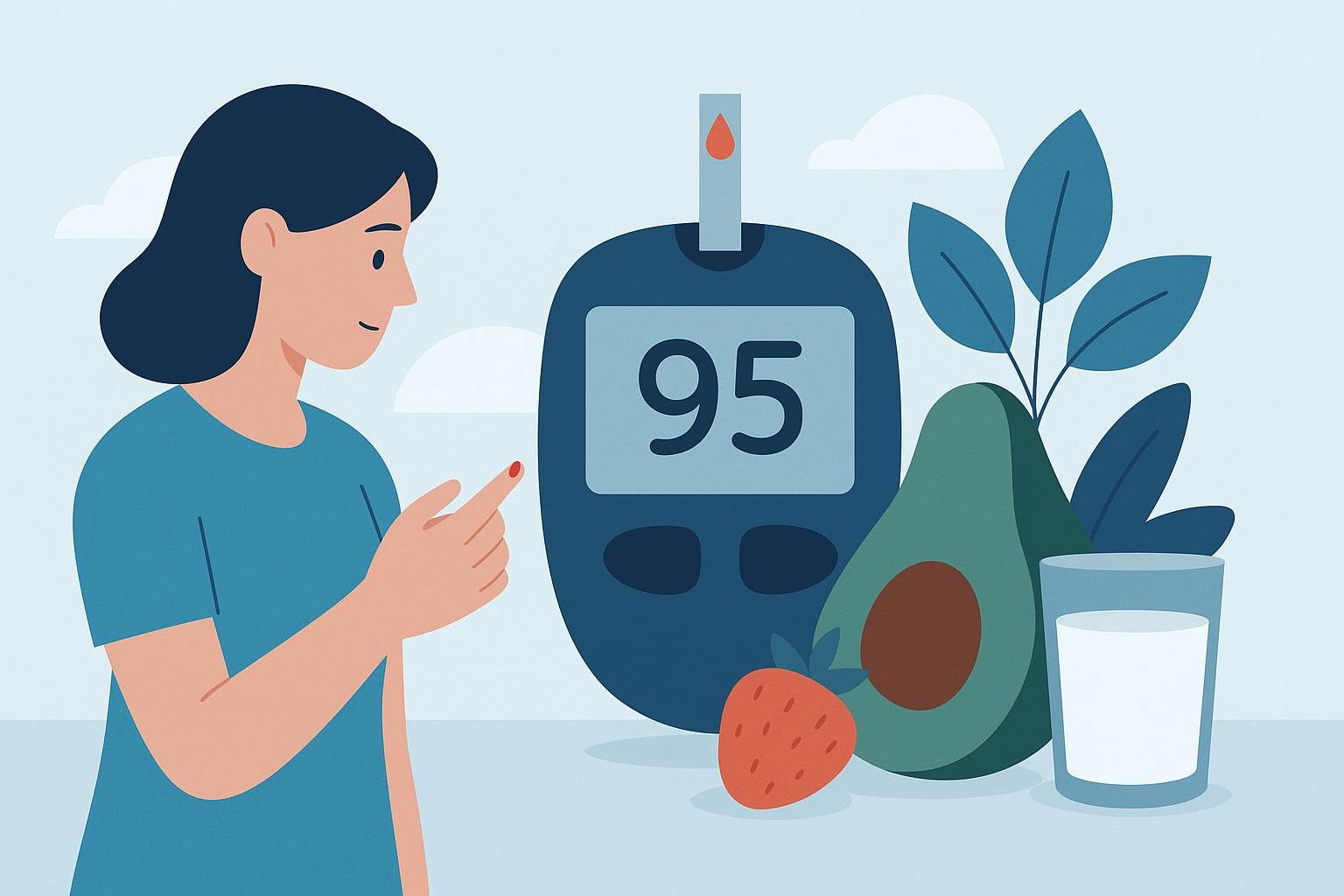People search for “diabetes reverse diet” to control blood sugar and lose weight. Learn how diet quality affects healthy eating and long-term health.
What Is a Diabetes Reversal Diet and How Does It Differ from a Regular Diabetes Diet

A diabetes reversal diet is a structured, healthy diet developed from scientific research and validated through multiple diabetes remission clinical trials.
It is recognized by the American Diabetes Association and supported by post hoc analysis showing its ability to improve insulin resistance and restore metabolic balance.
This plan helps the body use insulin properly and manage blood sugar more effectively.
-
It emphasizes healthy foods like whole grains, vegetables, and lean protein.
-
It encourages healthy meals made from fresh, unprocessed ingredients.
-
It limits added sugars and refined carbs that worsen glucose fluctuations.
These choices improve metabolic flexibility and support long-term disease control.
Consistent physical activity strengthens the diet’s effect by improving insulin sensitivity and aiding fat metabolism. Along with balanced eating habits, it reduces long-term complications linked to poor glucose control.
While no single plan guarantees remission, research suggests that maintaining a healthy weight, eating nutrient-dense foods, and managing portion sizes through mindful routines can help reverse insulin resistance and protect overall metabolic health.
Key Differences from a Typical Diabetes Diet
A diabetes reversal diet takes a more comprehensive and targeted approach than a standard diabetes diet. It addresses insulin dysfunction, not just blood sugar readings, aiming to reduce medication dependence and restore full metabolic function.
| Aspect | Typical Diabetes Diet | Diabetes Reversal Diet |
|---|---|---|
| Primary Goal | Manage glucose and control calorie intake | Improve insulin resistance and promote remission |
| Scientific Support | Based on general guidelines | Backed by diabetes remission clinical trials and American Diabetes Association consensus reports |
| Nutritional Focus | Portion control and calorie restriction | Evidence-based healthy diet that uses nutrient-dense healthy foods |
| Food Quality | May include low-sugar processed meals | Prioritizes whole, natural ingredients and healthy meals |
| Carbohydrate Strategy | Moderation of simple carbs | Strategic reduction to support insulin properly and stable glucose |
| Lifestyle Integration | Physical activity optional | Core component with movement and structured eating habits |
| Outcome | Maintains short-term stability | Strengthens disease control, supports healthy weight, and lowers long-term complications |
This comparison shows how a reversal plan rebuilds metabolism instead of only managing symptoms. Research suggests that combining whole-food nutrition, consistent movement, and behavior-focused structure creates measurable, lasting improvement in both glucose control and overall health.
Curious how this looks in daily life? Balance Bite shares easy swaps and full-day meal examples designed for blood sugar stability
Seven Reasons Why the Usual Diabetes Diet Fails in the Long Run

Most diabetes diets focus on blood sugar control and calorie intake but ignore the deeper causes of insulin resistance and metabolic syndrome. These plans often miss how inflammation, excess weight, and poor well being weaken long-term progress.
Understanding these flaws helps create a smarter, more sustainable healthy eating plan.
1. Too Focused on Short-Term Glucose Numbers
Short-term glucose control looks good on paper but fails to fix the problem. Lower readings do not always mean improved fasting blood glucose or stable insulin sensitivity.
-
Temporary drops in high blood sugar hide ongoing metabolic stress.
-
Ignoring fasting plasma glucose leaves insulin function weak.
Improving long-term stability requires focusing on deeper insulin recovery, not daily numbers.
2. Poor Attention to Calorie and Nutrient Quality
A good healthy eating plan balances calories with nutrient density. Many people eat fewer calories but rely on processed foods that delay recovery.
-
Reading food labels helps track hidden sugars and added fats.
-
Choosing healthy foods and healthy meals nourishes without overload.
Better food choices support steady glucose control and reduce long term complications.
3. Neglecting Healthy Fats
Avoiding all fats removes those that protect the heart and improve insulin resistance.
-
Use extra virgin olive oil and flax seeds for healthy omega-3s.
-
Replace saturated fats and trans fats with healthy fats that support balance.
These choices improve heart health, reduce inflammation, and build stronger overall health.
4. Over-Restriction and Poor Recovery
Severe restriction slows metabolism and raises weight regain, which is typically high after crash diets.
-
Very low calorie plans cause fatigue and hunger cycles.
-
Moderate, whole-food meals support steady weight loss and restore energy.
Progress lasts when eating habits fit real life and sustain good well being.
5. Skipping Protein and Fibre
Skipping balanced meals weakens glucose control and energy levels.
-
Include lean protein, whole grains, and foods high in fibre to use insulin properly.
-
These nutrients stabilize blood sugar levels and maintain healthy weight.
Regular, nutrient-rich meals strengthen both digestion and long term health.
6. Missing Behavior and Lifestyle Support
Nutrition alone cannot reverse diabetes. Real progress needs structure and consistency.
-
Regular physical activity improves insulin resistance and calorie use.
-
A lifestyle intervention supports better eating habits and emotional well being.
Healthy behavior patterns turn short-term success into sustainable disease control.
7. Limited Medical Oversight
Unsupervised diets risk poor nutrient balance and unsafe medication changes.
-
Medical support keeps diabetes care personalized and safe.
-
Doctors adjust diabetes medication based on updated fasting blood glucose results.
Professional guidance reduces high risk outcomes and improves confidence in long-term progress.
Simple habits make the difference. Drinking unsweetened iced tea, checking food labels, and limiting added fats strengthen everyday health. These steady actions improve heart health, well being, and disease control, helping people with type 2 diabetes move toward lasting balance.
See how people fixed these mistakes and rebuilt their health step-by-step. Read their journeys at Balance Bite
Seven Steps to Create a Healthy Eating Plan for Diabetes Reversal

Creating a structured eating plan for diabetes reversal means understanding how food, timing, and consistency affect your metabolism. Each step below outlines a specific area of focus that supports insulin repair, balanced glucose, and lasting energy while helping you achieve a lower risk of future complications.
1. Set Realistic Goals to Manage Excess Weight
Start by setting achievable goals that reduce excess weight without straining your body. Slow progress ensures that fat loss is sustainable and muscle is preserved.
-
Aim for steady, gradual changes instead of quick fixes.
-
Track progress through consistent weighing and portion awareness.
-
Celebrate small wins to keep motivation strong.
Practical goals create long-term momentum and protect against burnout.
2. Build a Foundation with a Healthy Diet
A healthy diet centers on whole, unprocessed foods that nourish rather than restrict. Nutrient density matters more than calorie cuts.
-
Choose vegetables, lean protein, and complex carbs for balance.
-
Limit refined grains and added sugars that spike glucose.
-
Plan meals that satisfy hunger and keep energy steady.
This foundation restores trust in food and supports long-term stability.
Want to see how small, realistic food changes can reshape your health? Explore practical meal ideas and real stories on Balance Bite
3. Balance Nutrients to Maintain a Steady Glycemic Index
Balancing macronutrients keeps your glycemic index stable and prevents energy crashes. Every meal should blend carbohydrates with protein and fat for slow digestion.
-
Pair grains with lean meat or legumes for steady release.
-
Add healthy fats like olive oil or nuts to balance absorption.
-
Avoid heavy carb-only meals that cause glucose spikes.
Consistent balance builds resilience in both blood sugar and mood.
4. Follow Evidence-Based Methods Proven in Clinical Trial Results
Look to clinical trial evidence for guidance instead of trends. Research-based methods show what truly supports insulin recovery and weight balance.
-
Structured low-calorie plans under supervision improve glucose control.
-
Nutrient-focused diets show measurable changes in metabolic health.
-
Ongoing data supports gradual, monitored change.
Evidence brings confidence and clarity to your daily choices.
5. Add Protein and Fibre to Strengthen Blood Sugar Control
Protein and fibre help regulate digestion and slow glucose absorption. They create lasting fullness while maintaining energy consistency.
-
Add beans, lentils, and whole grains to meals.
-
Pair lean meats or plant proteins with vegetables.
-
Use high-fibre snacks to avoid sugar cravings.
This combination supports steady metabolism and better insulin function.
6. Use Meal Timing and Portion Awareness for Lasting Balance
Meal timing matters as much as content. Spacing meals evenly improves glucose control and reduces overeating.
-
Eat at consistent times each day to stabilize hormones.
-
Keep portions moderate to avoid energy drops.
-
Include small, nutrient-rich snacks when needed.
Consistent timing strengthens your body’s rhythm and digestion.
7. Support Progress with Hydration and Consistent Physical Activity
Water and movement keep metabolism active and steady. Hydration supports kidney function, while exercise increases insulin use and heart health.
-
Drink enough water or unsweetened tea through the day.
-
Aim for 30 minutes of light to moderate physical activity daily.
-
Combine hydration with balanced meals for best results.
Together, these habits anchor progress and strengthen endurance for the long term.
Five Definite Signs That Your Diet Is Working

A structured diabetes diet takes time to show measurable results. As your body adjusts to better nutrition and improved insulin sensitivity, small but consistent signals appear. These signs confirm that your healthy eating plan is supporting real metabolic repair, not just temporary progress.
1. Improved Blood Sugar and Energy Stability
Better control of blood sugar marks the first stage of progress. Lower fasting plasma glucose and steady daily readings show that your metabolism is responding.
-
Fewer sugar crashes mean stronger energy and focus.
-
Consistent levels suggest improved insulin use and stable fuel supply.
These changes reflect a smoother metabolic rhythm and healthier blood sugar levels overall. When these trends persist, they show that your plan is promoting deeper balance, not short-term control.
2. Steady, Healthy Weight Loss
Healthy weight loss happens gradually and signals real metabolic improvement. Rapid loss usually fades, but slow, consistent progress sustains overall health.
-
Maintaining a healthy weight supports insulin recovery and reduces long term complications.
-
Moderate calorie control helps the body lose weight without stress.
This pattern shows that your body is adjusting to a steady healthy diet, not fighting it. The longer this stability continues, the stronger your foundation for lasting disease control.
3. Higher Energy and Focus
More energy and sharper focus are signs of better nutrient balance. Choosing healthy foods and avoiding processed foods helps regulate your glucose supply and mental clarity.
-
Balanced meals stabilize energy throughout the day.
-
Whole ingredients reduce inflammation and improve well being.
Your body works efficiently when glucose and oxygen supply remain steady. These improvements prove that food is now supporting both your body and your mind.
4. Improved Lab Results
Strong numbers in your medical reports confirm that your plan is working. Lower cholesterol levels, better kidney function, and balanced triglycerides show stronger metabolic repair.
-
These outcomes mirror results from major diabetes remission clinical trials and post hoc analysis reviews.
-
Improved readings lower your risk of heart disease and future high risk complications.
Consistent progress across these markers indicates measurable healing, not coincidence. Clinical improvements strengthen the scientific case for structured, nutrient-based reversal programs.
5. Reduced Need for Medication
As insulin sensitivity improves, your body may need less medication to maintain control. Lower dosage adjustments under medical supervision signal real success.
-
Doctors may reduce your diabetes medication gradually.
-
Better results show improved internal balance and sustainable diabetes care.
Medication reduction is never the first goal but becomes possible with steady improvement. When your diet supports natural glucose regulation, it proves that lasting change is underway, not just a temporary fix.
Maintaining Long-Term Health and Preventing Complications

Long-term success in diabetes management depends on steady habits and ongoing awareness. A balanced heart healthy diet paired with consistent activity supports stable blood sugar levels and lasting disease control.
The goal is to strengthen organs, preserve energy, and prevent complications before they begin. Balanced nutrition creates lasting protection.
-
Include healthy foods that lower inflammation and maintain a healthy weight.
-
Avoid processed foods and simple carbohydrates that raise glucose levels and stress the body.
-
Choose whole ingredients rich in fibre and nutrients to support overall health.
These patterns reduce the risk of heart strain and kidney failure, protecting vital systems long term.
Prevention extends beyond the plate.
-
Regular checkups track progress in diabetes care and help manage diabetes medication effectively.
-
Consistent physical activity and mindful eating habits reduce weight regain and keep metabolism balanced.
-
Staying hydrated and aware of portion size maintains energy and comfort throughout the day.
These small steps protect the body from decline and improve resilience over time.
When eating, movement, and mindset work together, progress becomes protection. This structure maintains long term health and builds strength that endures through every stage of care.
When to Seek Professional Help

Professional guidance becomes essential when progress slows or symptoms change. Even a well-structured plan benefits from expert oversight to ensure safety and alignment with your health goals. Seeking help early prevents small issues from developing into long-term challenges.
Medical supervision supports proper diabetes care through precise monitoring and adjustment.
-
Doctors can evaluate your medication needs and check for hidden nutrient gaps.
-
Dietitians help fine-tune portion sizes and meal composition for better results.
-
Regular lab reviews identify trends before they affect your progress.
This partnership keeps your plan both effective and personalized.
If your excess weight remains stubborn, or fatigue and glucose swings continue, a deeper review may be needed.
-
A professional can recommend structured meal timing or introduce more complex carbohydrates for sustained energy.
-
Tailored guidance ensures calorie balance without nutrient loss.
Close collaboration turns guesswork into data-driven improvement.
Professional help strengthens every part of your journey. It builds accountability, refines your strategy, and ensures your health plan continues to serve your long-term stability.
Frequently Asked Questions
1. Can Very Low-Calorie Diets Reverse Diabetes?
Diabetes remission clinical trials show that a very low calorie diet over about eight weeks can help the body use insulin properly. These plans help people eat fewer calories safely under supervision to prevent long term complications.
2. What Are the Best Foods to Eat?
Choose specific foods like whole grains, brown rice, legumes, and flax seeds. Avoid red meat, saturated fats, and trans fats to protect heart health and support overall health.
3. How Do I Maintain Healthy Eating Habits?
Build steady eating habits by balancing meals, keeping portions moderate, and not skipping breakfast. A strong lifestyle intervention makes these patterns consistent and easy to follow.
4. Why Do I Sometimes Regain Weight After Dieting?
Weight regain often happens when restrictive plans end or processed foods return. Eating more calories than needed slows progress. Regular physical activity helps prevent rebound.
5. What Are the Long-Term Benefits?
Balanced eating habits, better insulin sensitivity, and steady blood sugar levels lead to lasting health benefits. These changes lower the risk of developing diabetes and reduce long term complications.
Conclusion
If you’ve read this far, you already know that reversing diabetes isn’t about quick fixes or miracle foods. It’s about reclaiming control—through consistency, awareness, and trust in what your body can do when given the right support.
Change doesn’t happen overnight, but it begins the moment you decide to apply what you’ve learned. Start small: cook one meal with intention, move your body today, or schedule that check-in you’ve been delaying.
Each step compounds. Each choice adds up. And one day, the habits you build won’t just manage your blood sugar—they’ll redefine your health story.
You’ve learned what works. Now see how others live it every day. Explore real plans, tips, and support at Balance Bite




















Leave a comment
Translation missing: en.blogs.comments.discription